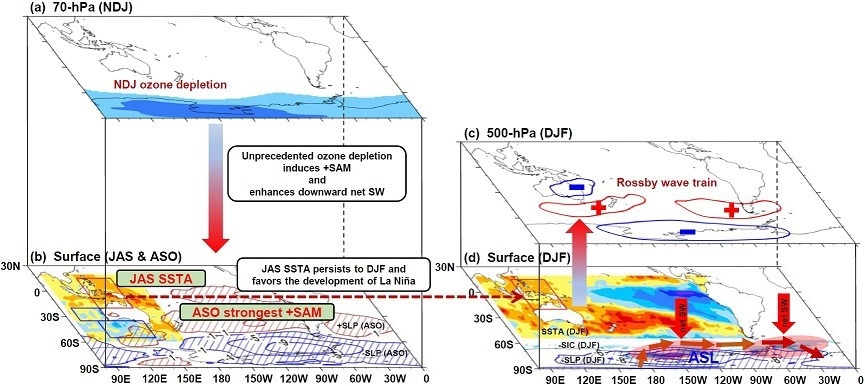Antarctic sea ice is a key component of the climate system and may serve as an early indicator of climate change. Substantial changes in Antarctic sea ice have been reported as a result of global warming. It specifically witnessed a steady increase from 1979 to 2014, followed by a fast decrease.
 Schematic of the physical mechanisms involved in the record-low sea ice area in austral summer 2022. Image Credit: Chao Zhang.
Schematic of the physical mechanisms involved in the record-low sea ice area in austral summer 2022. Image Credit: Chao Zhang.
Despite a minor recovery following the record low in 2017, the sea ice area during austral summer 2022 (December 2021 to February 2022) reached a new low, at 3.07 million km2, indicating a 25% decline from the long-term mean from 1981 to 2010. The most significant declines occurred in two areas: the central-eastern Ross Sea to the western Amundsen Sea and the eastern Bellingshausen Sea to the northern Weddell Sea.
This latest record low transpired only five years after the last record low in the summer of 2017, which is startling and raises concerns about climate change in the Antarctic.
Prof. Shuanglin Li from the Institute of Atmospheric Physics, Chinese Academy of Sciences, Beijing, China, and Dr. Chao Zhang from the China University of Geosciences, Wuhan, China, tried to find out the underlying mechanisms of this record-low sea ice area in a paper published in Atmospheric and Oceanic Science Letters.
We found that the combination of stronger positive sea surface temperature anomalies in the Maritime Continent during July–September 2021 and the preceding near-strongest positive-phase Southern Annular Mode during August–October 2021 induced a deepened and southwestward-shifted Amundsen Sea Low, causing sea ice retreat via horizontal wind anomalies.
Shuanglin Li, Professor, Institute of Atmospheric Physics, Chinese Academy of Sciences
The former lasted throughout summer and aided the development of La Niña, which caused an atmospheric wave train to originate in eastern Australia and propagate southeastward, remotely intensifying the Amundsen Sea Low. The latter stayed relatively strong due to the stratospheric cooling effect of extraordinary ozone reduction, which resulted in a deeper and southwestward-shifted Amundsen Sea Low.
The unprecedented ozone reduction also played a role through the induced surface warming in the West Antarctic by increasing downward shortwave radiation. Additionally, positive feedback between sea surface temperatures, net shortwave radiation, and cloudiness, along with the Ekman heat transport, amplified the surfacing warming.
Shuanglin Li, Professor, Institute of Atmospheric Physics, Chinese Academy of Sciences
Journal Reference:
Zhang, C., & Li, S. (2023). Causes of the record-low Antarctic sea-ice in austral summer 2022. Atmospheric and Oceanic Science Letters. doi.org/10.1016/j.aosl.2023.100353.